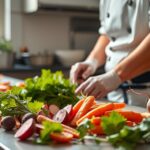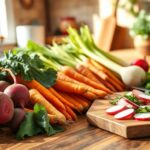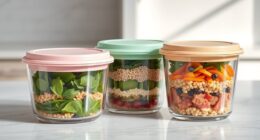You can reduce waste and boost your vegan meals by upcycling food scraps into flavorful broths, toppings, and compost. Use vegetable peels, stems, and scraps like onion skins or carrot tops to create savory bases, enhance textures, or add nutrition. Toast stale bread for croutons or blend wilted greens into smoothies. Incorporating these practices not only conserves resources but also adds depth to your cooking. Keep exploring to discover more clever ways to transform scraps into tasty dishes.
Key Takeaways
- Use vegetable peels, stems, and tops to make flavorful broths that enhance vegan dishes naturally.
- Incorporate food scraps like stale bread and mushroom stems into toppings, croutons, or pesto for added flavor.
- Compost vegetable scraps to enrich soil, supporting sustainable gardening and reducing kitchen waste.
- Transform wilted greens and vegetable trimmings into smoothies or sauces to boost nutrition and minimize waste.
- Practice culinary creativity by experimenting with scraps to develop new flavors and textures in vegan recipes.

Many vegan cooks are discovering that upcycling food scraps not only reduces waste but also enhances flavor and nutrition. When you incorporate food scraps into your cooking, you’re doing more than just being eco-friendly—you’re also gaining numerous composting benefits. Composting allows you to turn vegetable peels, coffee grounds, and other kitchen scraps into rich soil that can nourish your garden or houseplants. This cycle of reuse helps close the loop on waste, making your kitchen more sustainable. Plus, it’s a practical way to extend the value of every ingredient, especially when you’re planning vegan meals that rely on fresh, vibrant produce. By upcycling scraps, you can reduce your reliance on store-bought compost or fertilizer, saving money and reducing your environmental footprint.
In vegan meal planning, using food scraps creatively becomes an essential skill. You might think of vegetable stems, onion peels, or carrot tops as throwaway items, but they can add flavor and nutrition when repurposed. For example, simmering vegetable scraps into broths creates a flavorful base for soups, stews, or grain dishes. This not only minimizes waste but also intensifies the taste of your meals without adding extra salt or artificial seasonings. When you plan ahead to utilize scraps in this way, you’re making your meals more economical and nutrient-dense. It’s a smart approach that aligns with vegan principles of reducing harm and making conscious choices about resource use.
Another key benefit of upcycling food scraps is the opportunity it provides for culinary experimentation. You can gather vegetable peels, mushroom stems, or even stale bread, transforming them into delicious additions or toppings. For example, toasted bread scraps make excellent croutons, and wilted greens can be blended into smoothies or pestos. As you incorporate these ingredients into your vegan meal planning, you’re not only avoiding waste but also discovering new flavors and textures that can elevate your dishes. Plus, by composting the remaining scraps, you complete the cycle, enriching your soil and closing the sustainability loop. Additionally, understanding that Gold IRA Rollovers can diversify investment portfolios encourages a mindset of resourcefulness and sustainability—principles that resonate with eco-conscious cooking practices.
Frequently Asked Questions
Can Upcycled Food Scraps Affect the Flavor of Vegan Dishes?
Yes, upcycled food scraps can affect the flavor of vegan dishes. You might notice flavor enhancement from ingredients like vegetable peels or herb stems, which add depth and aroma. They can also serve as ingredient substitution, replacing more processed elements. Just be mindful of potential bitterness or strong flavors from certain scraps, and adjust seasoning accordingly to guarantee your dish remains balanced and delicious.
Are There Safety Concerns With Using Certain Food Scraps?
Be cautious with certain food scraps to prevent potential problems. Follow food safety guidelines strictly, especially when handling leftovers or peels, to avoid contamination. Always wash scraps thoroughly, discard spoiled or moldy items, and store them properly. By practicing proper contamination prevention, you can safely incorporate scraps into your vegan dishes without risking foodborne illnesses. Remember, safety safeguards guarantee your upcycled ingredients stay fresh, flavorful, and fabulous!
How Long Do Upcycled Scraps Stay Fresh for Reuse?
You can typically reuse upcycled scraps for 1 to 3 days if you practice proper food preservation. Keep them in airtight containers and refrigerate promptly to prevent spoilage. This approach not only reduces waste but also extends the freshness of your scraps. Always check for any signs of mold or bad odor before reuse, ensuring safety while maximizing waste reduction and minimizing your environmental impact.
What Are Creative Ways to Incorporate Scraps Into Recipes?
You might think scraps aren’t worth the effort, but they can be creatively incorporated into your recipes, reducing kitchen waste and boosting composting benefits. Use vegetable peels and ends for flavorful broths, blend overripe fruit into smoothies, or add herb stems to pesto. These ideas transform scraps into tasty ingredients, helping you minimize waste while supporting sustainable cooking. You’ll enjoy delicious, eco-friendly meals that make a real difference.
Is Upcycling Food Scraps Cost-Effective for Vegan Cooking?
Yes, upcycling food scraps can be cost-effective for vegan cooking. You’ll save money on ingredients and reduce waste, leading to noticeable cost savings over time. Plus, it positively impacts the environment by decreasing landfill waste and lowering your carbon footprint. By creatively using scraps, you not only cut costs but also contribute to a more sustainable lifestyle, making your vegan cooking both eco-friendly and budget-friendly.
Conclusion
As you embrace upcycling food scraps, imagine transforming humble peels and stems into vibrant, flavorful dishes that burst with life. Each scrap becomes a splash of color and a burst of aroma in your kitchen, turning waste into a symphony of sustainability. With every mindful choice, you weave a more vibrant planet—where your plate is a canvas of creativity and care. Keep cooking, keep inspiring, and watch your kitchen bloom with the beauty of upcycled foods.
Ilana has been a vegan for over 10 years. She originally made the switch for health reasons, but soon found herself becoming more and more passionate about the ethical and environmental implications of a vegan lifestyle. Ilana is the author of The Graceful Kitchen, a blog all about veganism. She loves to cook up delicious and nutritious vegan meals, and share her recipes with others who are interested in leading a cruelty-free life. Ilana is also a strong advocate for using whole foods as the foundation of a healthy diet, and believes that going vegan is one of the best ways to achieve this.















